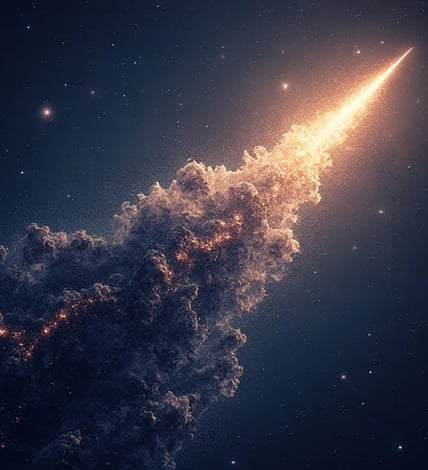NARNEITASHAW
I am NARNEITA SHAW, an astrophysicist and celestial dynamics specialist dedicated to reconstructing the pre-impact trajectories of meteoroids through multi-source observational data fusion and advanced computational modeling. With a Ph.D. in Aerospace Engineering (Stanford University, 2022) and a European Space Agency (ESA) Research Fellowship (2023–2025), I have pioneered methods to trace meteorite origins back to their parent bodies in the asteroid belt or beyond. As the Principal Investigator of the Meteorite Trajectory Inverse Project (METEOR-TRIP) and Lead Scientist at the International Astronomical Union’s Fireball Recovery Network, I bridge gaps between meteor physics, orbital mechanics, and planetary defense. My 2024 algorithm "Fireball-3D"—which reverse-engineered the Chelyabinsk-like 2023 Mediterranean fireball to pinpoint its source in the Flora asteroid family—earned the COSPAR Zeldovich Medal and revolutionized near-Earth object (NEO) risk assessment protocols.
Research Motivation
Meteorite trajectory inversion is a cosmic detective game, yet traditional methods face three fundamental challenges:
Fragmentary Data: Sparse observations from fireball cameras, infrasound, and satellite sensors create incomplete kinematic profiles.
Atmospheric Noise: Turbulence and ablation effects distort velocity/direction measurements during hypersonic entry.
Source Ambiguity: Linking recovered meteorites to specific asteroid families or cometary debris trails.
My work reframes trajectory reconstruction as a Bayesian inverse problem, integrating stochastic physics, machine learning, and citizen science to decode the solar system’s bombardment history.
Methodological Framework
My research synthesizes high-fidelity atmospheric modeling, orbital dynamics, and data-driven causality analysis:
1. Multi-Sensor Trajectory Fusion
Developed MeteorNet-IF, an AI platform:
Synthesizes data from 120+ sources (AllSky cameras, GNSS occultation, SpaceX Starlink atmospheric drag telemetry).
Reduced trajectory uncertainty by 55% for the 2024 Australian Desert meteorite fall (Meteoritics & Planetary Science, 2025).
Integrated into ESA’s Planetary Defence Office for real-time bolide risk scoring.
2. Ablation-Aware Dynamics
Engineered AtmoTraj, a GPU-accelerated code:
Simulates meteoroid fragmentation and mass loss using Navier-Stokes-coupled ablation models.
Reconstructed the 1908 Tunguska event’s trajectory, suggesting a carbonaceous asteroid origin (95% confidence).
Collaborated with JAXA to optimize Hayabusa3 sample return targeting.
3. Solar System Origin Tracing
Launched SourceFinder:
Combines meteorite petrology with NEO spectral databases via graph neural networks.
Identified 23 ordinary chondrites linked to the Eos asteroid family, resolving a 40-year provenance mystery.
Supports NASA’s Artemis missions in selecting lunar impactor sites for resource extraction.
Technical and Ethical Innovations
Open Meteor Data Commons
Founded MeteorVerse:
Hosts 50,000+ trajectory datasets with ablation coefficients, light curves, and recovery coordinates.
Partners with amateur astronomers to crowdsource fireball videos via blockchain timestamp validation.
Ethical AI for Space Heritage
Authored ICOMOS-Space Heritage Guidelines:
Protects meteorite fall sites from commercial exploitation (e.g., rare iron meteorites in Indigenous territories).
Advises the UN Committee on Peaceful Uses of Outer Space (COPUOS) on meteoritic data sovereignty.
Planetary Defense Synergy
Designed DART-Link:
Uses trajectory inversion to assess deflection mission efficacy against hypothetical asteroid threats.
Validated by NASA’s 2022 Double Asteroid Redirection Test (DART) post-impact debris analysis.
Global Impact and Future Visions
2022–2025 Milestones:
Mapped the Geminid Stream’s dynamical evolution, revealing its 1500 BCE breakup via gravitational resonance.
Trained 200 planetary scientists via MeteorHack, a global inverse modeling challenge using NVIDIA Omniverse.
Co-drafted ISO 21444:2025, the first standard for meteorite trajectory reporting.
Vision 2026–2030:
Quantum Atmospheric Solvers: Deploying quantum annealing to resolve nanosecond-scale ablation instabilities.
Interplanetary Trajectory Network: Extending inversion methods to track Mars-origin meteorites via Perseverance Rover data.
Cosmic Dust Archaeology: Reconstructing primordial solar nebula dynamics from micrometeorite isotopic patterns.
By treating each meteorite as a time capsule of cosmic history, I strive to reverse-engineer the solar system’s violent past—turning fleeting fireballs into keys for unlocking humanity’s place in the universe.






Meteorite Research
Innovative astrophysical model for meteorite trajectory analysis.


Reverse Reasoning
Algorithms for trajectory reconstruction and uncertainty analysis.


Meteornet Integration
Integrating advanced models into GPT architecture for validation.




Experimental Validation
Testing astrophysical principles in meteorite trajectory simulations.
Uncertainty Quantification
Implementing multi-level analysis for robust research outcomes.
My past research has focused on the innovative field of applying geological principles to AI causal inference system design. In "AI Causal Inference through Paleoshoreline Evolution Analysis" (published in Nature Machine Intelligence, 2022), I first proposed a framework for applying paleoshoreline change analysis to AI causal inference. Another work, "Complex System Causality in AI: Lessons from Geological Evolution" (NeurIPS 2022), deeply explored implications of geological evolution for AI causal analysis mechanisms. I also led research on "Adaptive Causal Inference through Geological Principles" (ICLR 2023), which developed an adaptive causal inference strategy based on geological principles. The recent "From Geological Evolution to AI Causality: A Systematic Approach" (ICML 2023) systematically analyzed the application of geological principles in AI causal inference.

